Abstract
1. Much attention has been given to the effects of various classes of antihypertensive drugs on blood pressure and haemodynamics. The effects of a single bout of exercise on post-exercise blood pressure have also been studied by several investigators. However, the combined effects of prior exercise and antihypertensive medication has drawn less attention. 2. We examined the separate and combined effects of a single bout of exercise and of angiotensin converting enzyme (ACE) inhibition with a new ACE inhibitor (fosinopril, 20 mg day(-1)) on post-exercise blood pressure and systemic and regional haemodynamics. Ten patients with mild-to-moderate hypertension were studied with a double-blind, randomized crossover, placebo- and rest period-controlled study design. 3. At rest, mean arterial pressure (MAP, -10 +/- 2 mm Hg), total peripheral resistance (TPR, -11 +/- 5%) and forearm vascular resistance (FVR, -17 +/- 8%) were significantly (P < 0.05) reduced during ACE inhibition as compared with the placebo phase. 4. During the placebo phase, MAP (-3 +/- 1 mm Hg), TPR (-10 +/- 4%) and FVR (-9 +/- 4%) were lower after exercise as compared with the control rest period. 5. During ACE inhibition, MAP (-3 +/- 1 mm Hg) and TPR (-8 +/- 4%) were lower, but FVR (+32 +/- 15%) was increased after exercise as compared with the control rest period. 6. Thus, blood pressure and TPR decreased similarly after exercise during the placebo phase and during ACE inhibition. However, differences in post-exercise forearm haemodynamics during the placebo phase and during ACE inhibition indicate that underlying regional haemodynamics are modified.
Full text
PDF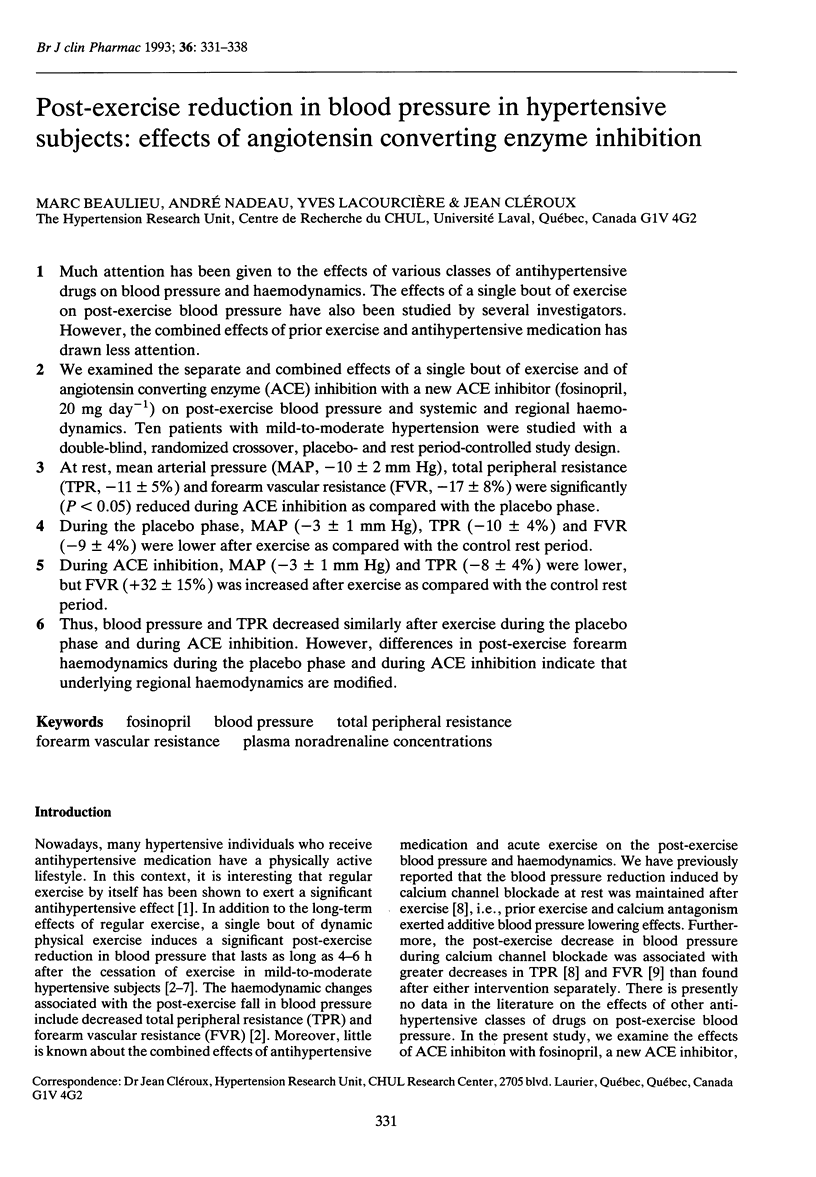
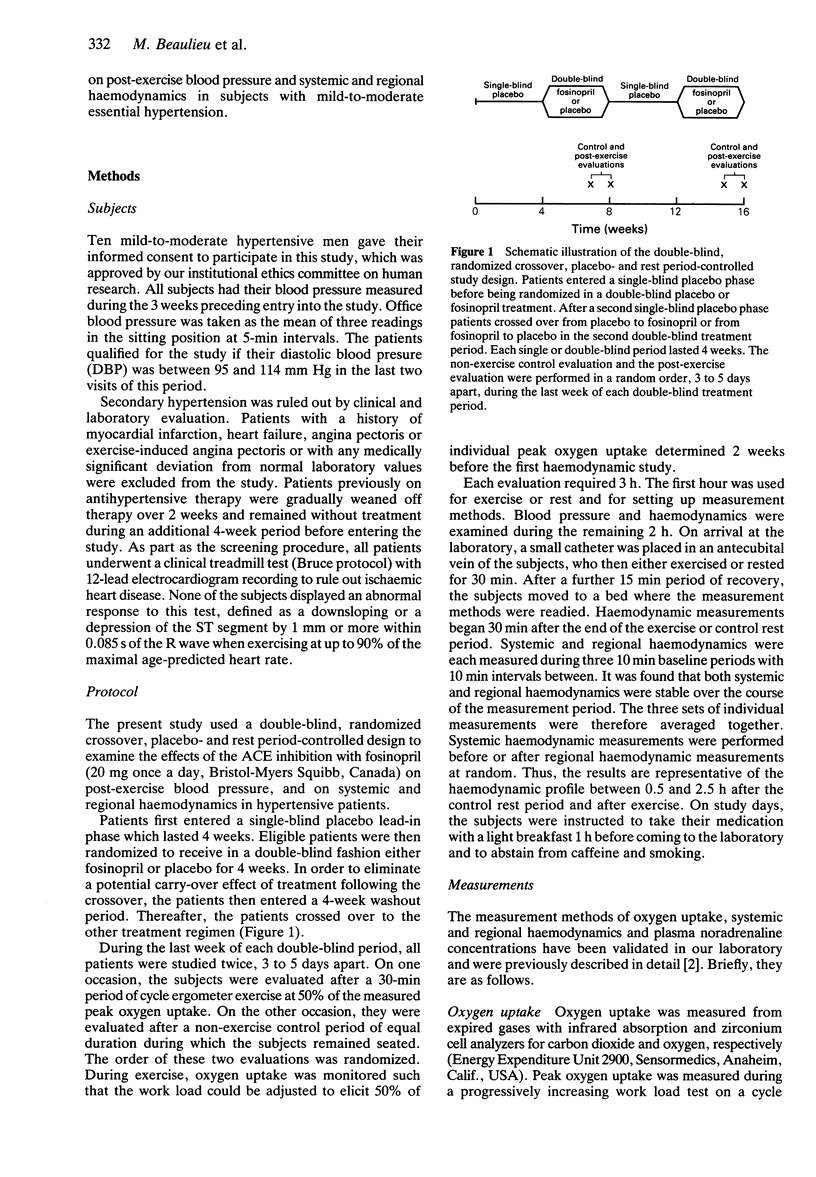
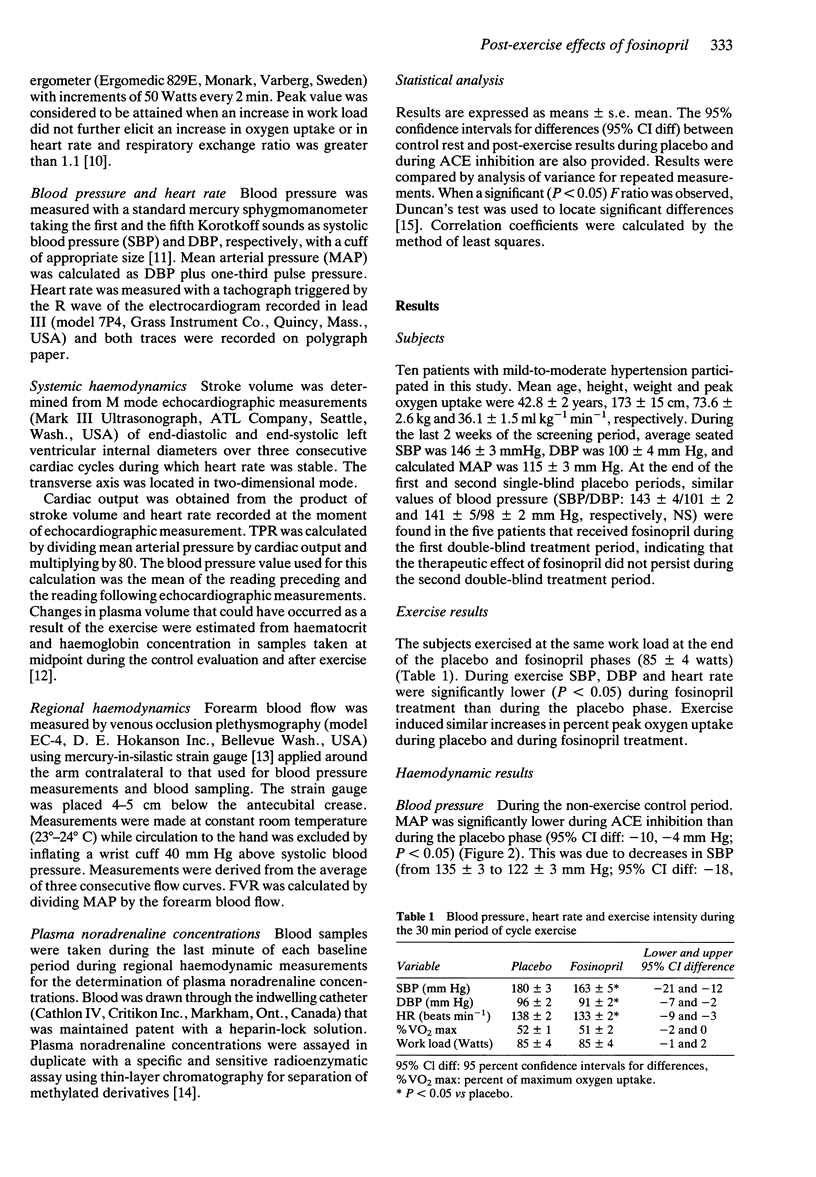
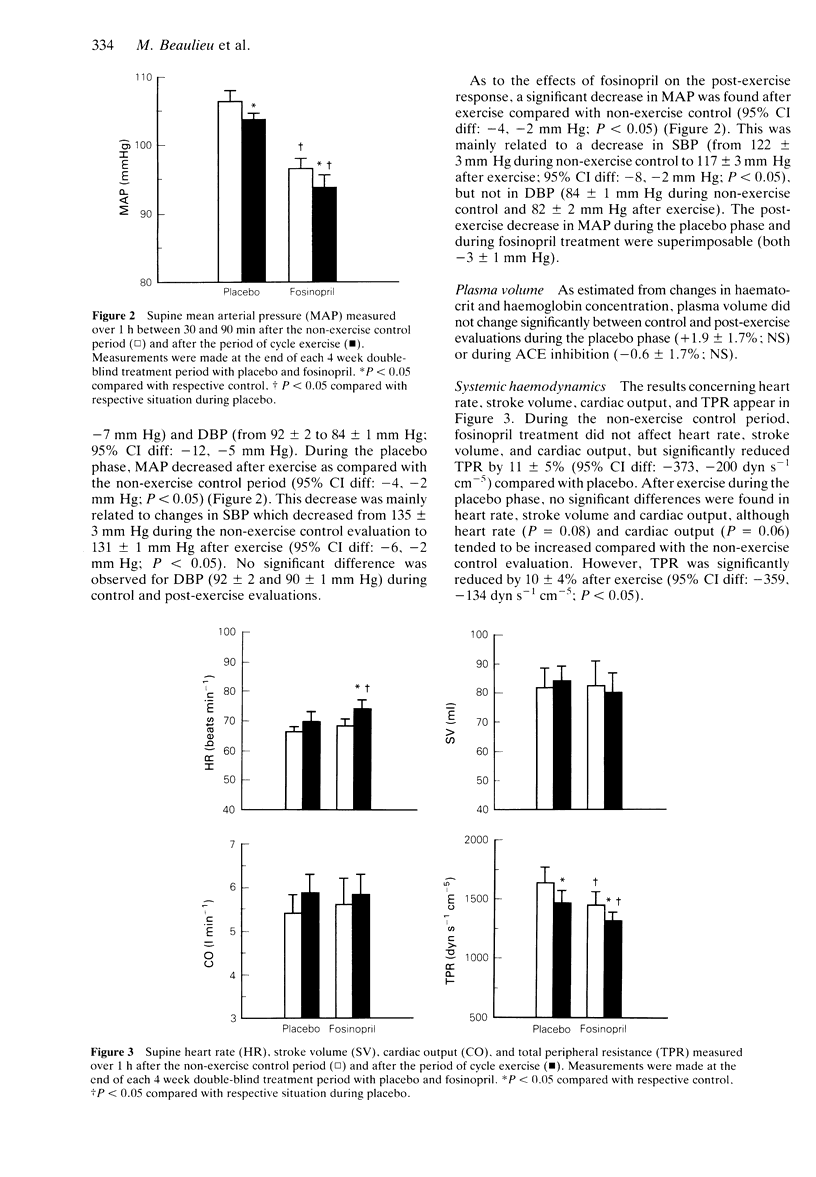
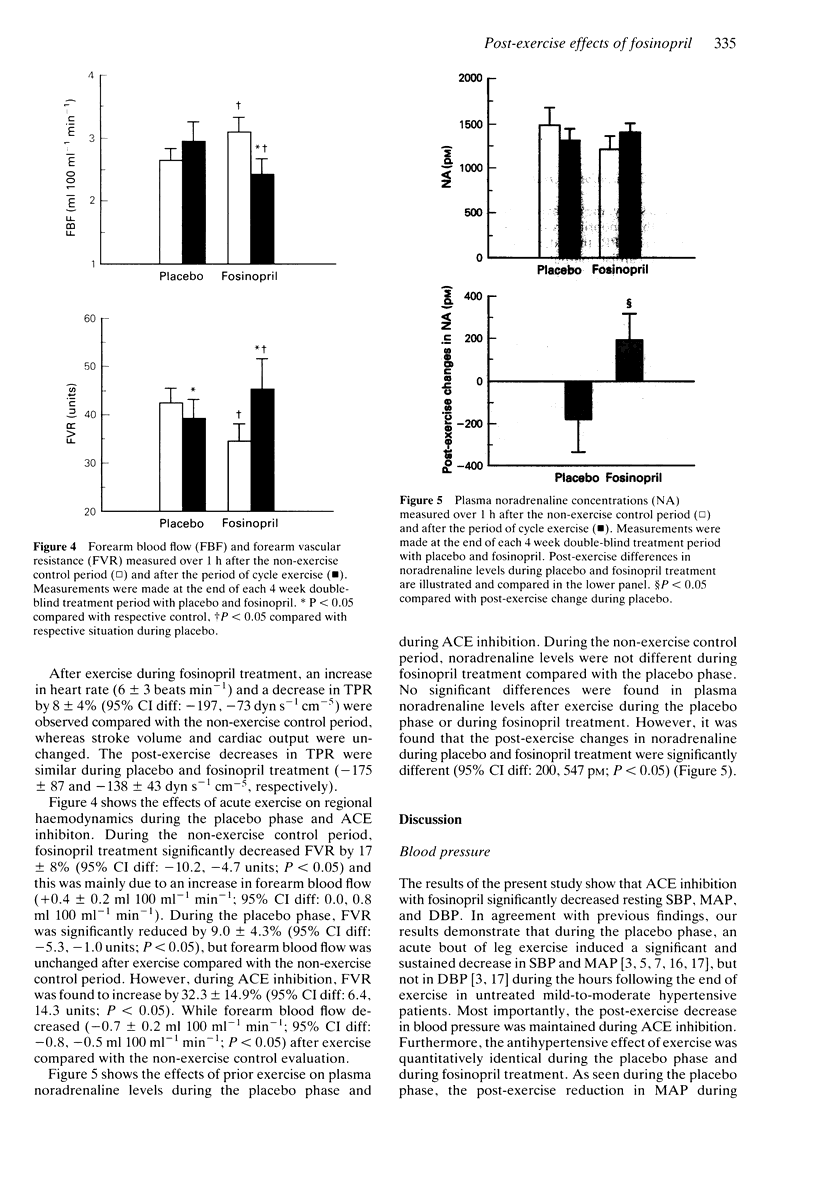

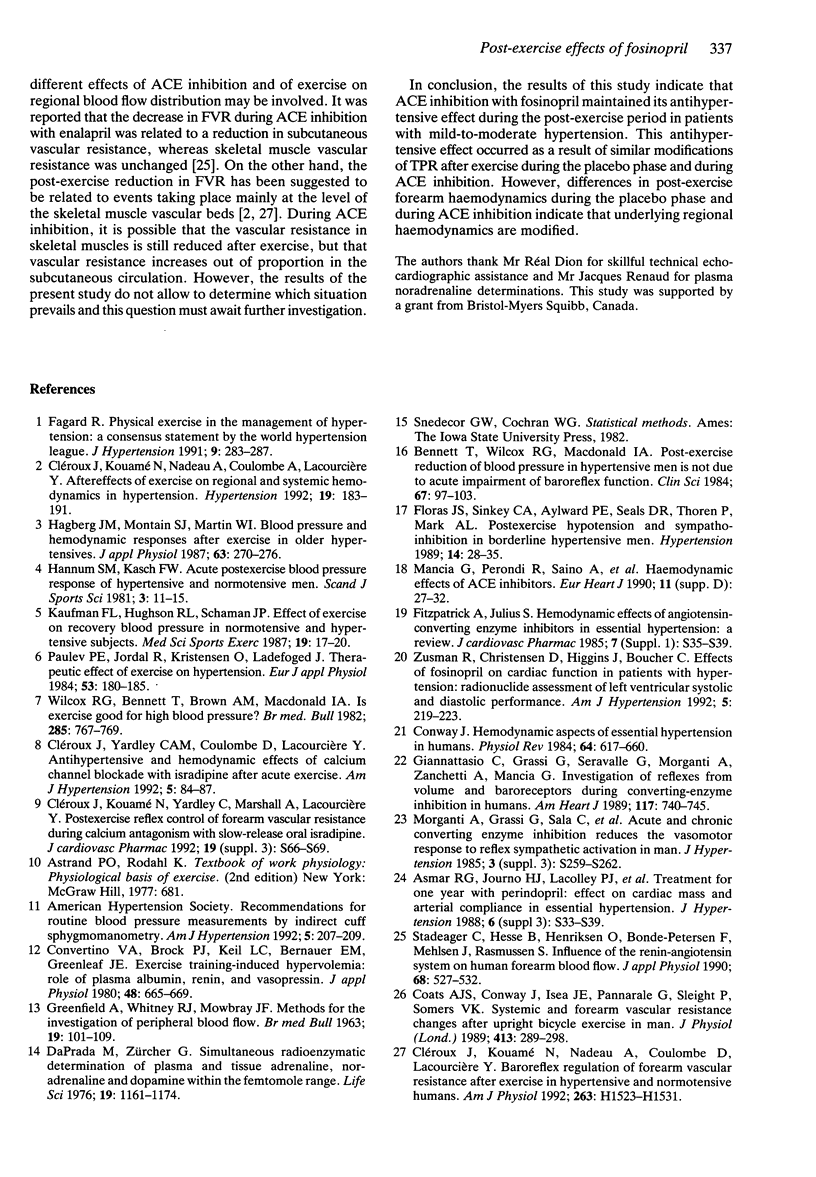
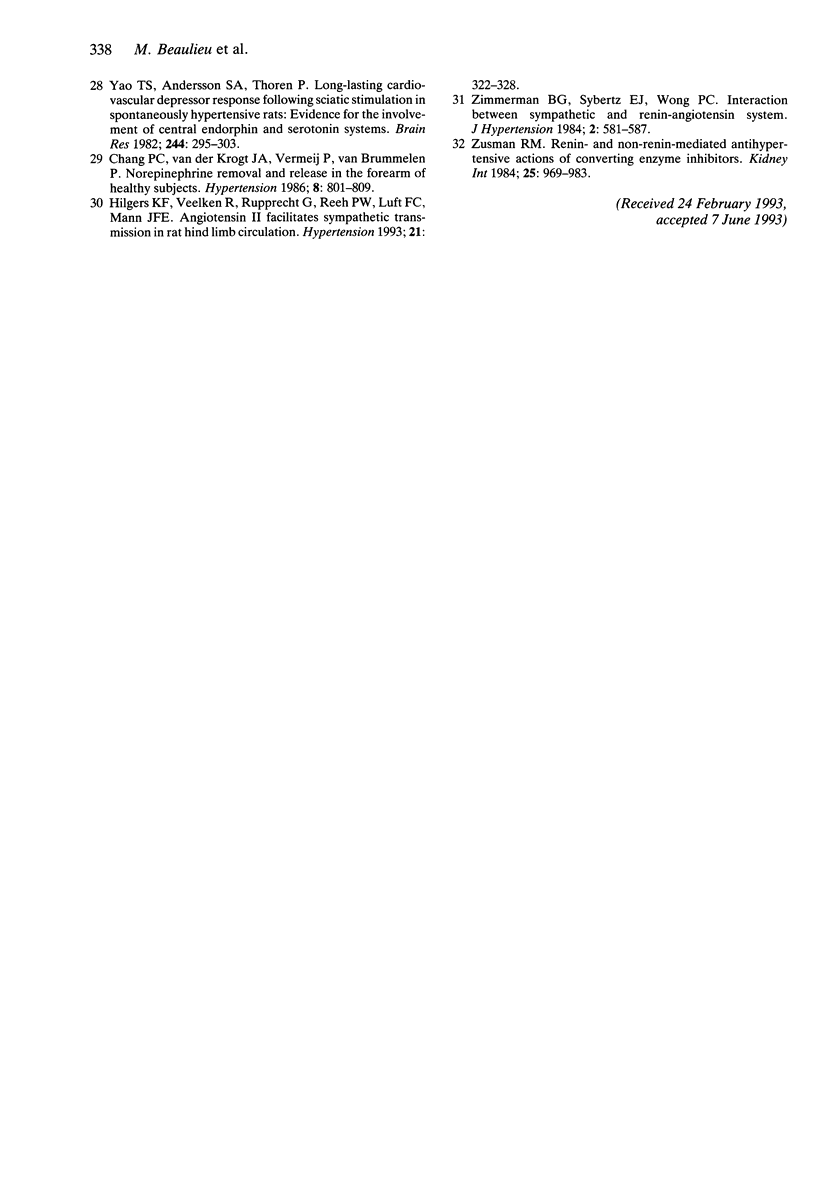
Selected References
These references are in PubMed. This may not be the complete list of references from this article.
- Asmar R. G., Journo H. J., Lacolley P. J., Santoni J. P., Billaud E., Levy B. I., Safar M. E. Treatment for one year with perindopril: effect on cardiac mass and arterial compliance in essential hypertension. J Hypertens Suppl. 1988 Dec;6(3):S33–S39. [PubMed] [Google Scholar]
- Bennett T., Wilcox R. G., Macdonald I. A. Post-exercise reduction of blood pressure in hypertensive men is not due to acute impairment of baroreflex function. Clin Sci (Lond) 1984 Jul;67(1):97–103. doi: 10.1042/cs0670097. [DOI] [PubMed] [Google Scholar]
- Chang P. C., van der Krogt J. A., Vermeij P., van Brummelen P. Norepinephrine removal and release in the forearm of healthy subjects. Hypertension. 1986 Sep;8(9):801–809. doi: 10.1161/01.hyp.8.9.801. [DOI] [PubMed] [Google Scholar]
- Cléroux J., Kouamé N., Nadeau A., Coulombe D., Lacourciere Y. Baroreflex regulation of forearm vascular resistance after exercise in hypertensive and normotensive humans. Am J Physiol. 1992 Nov;263(5 Pt 2):H1523–H1531. doi: 10.1152/ajpheart.1992.263.5.H1523. [DOI] [PubMed] [Google Scholar]
- Cléroux J., Kouamé N., Nadeau A., Coulombe D., Lacourcière Y. Aftereffects of exercise on regional and systemic hemodynamics in hypertension. Hypertension. 1992 Feb;19(2):183–191. doi: 10.1161/01.hyp.19.2.183. [DOI] [PubMed] [Google Scholar]
- Cléroux J., Kouamé N., Yardley C., Marshall A., Lacourcière Y. Postexercise reflex control of forearm vascular resistance during calcium antagonism with slow-release oral isradipine. J Cardiovasc Pharmacol. 1992;19 (Suppl 3):S66–S69. [PubMed] [Google Scholar]
- Cléroux J., Yardley C., Marshall A., Coulombe D., Lacourcière Y. Antihypertensive and hemodynamic effects of calcium channel blockade with isradipine after acute exercise. Am J Hypertens. 1992 Feb;5(2):84–87. doi: 10.1093/ajh/5.2.84. [DOI] [PubMed] [Google Scholar]
- Coats A. J., Conway J., Isea J. E., Pannarale G., Sleight P., Somers V. K. Systemic and forearm vascular resistance changes after upright bicycle exercise in man. J Physiol. 1989 Jun;413:289–298. doi: 10.1113/jphysiol.1989.sp017654. [DOI] [PMC free article] [PubMed] [Google Scholar]
- Convertino V. A., Brock P. J., Keil L. C., Bernauer E. M., Greenleaf J. E. Exercise training-induced hypervolemia: role of plasma albumin, renin, and vasopressin. J Appl Physiol Respir Environ Exerc Physiol. 1980 Apr;48(4):665–669. doi: 10.1152/jappl.1980.48.4.665. [DOI] [PubMed] [Google Scholar]
- Conway J. Hemodynamic aspects of essential hypertension in humans. Physiol Rev. 1984 Apr;64(2):617–660. doi: 10.1152/physrev.1984.64.2.617. [DOI] [PubMed] [Google Scholar]
- Da Prada M., Zürcher Simultaneous radioenzymatic determination of plasma and tissue adrenaline, noradrenaline and dopamine within the femtomole range. Life Sci. 1976 Oct 15;19(8):1161–1174. doi: 10.1016/0024-3205(76)90251-4. [DOI] [PubMed] [Google Scholar]
- Fitzpatrick M. A., Julius S. Hemodynamic effects of angiotensin-converting enzyme inhibitors in essential hypertension: a review. J Cardiovasc Pharmacol. 1985;7 (Suppl 1):S35–S39. doi: 10.1097/00005344-198507001-00008. [DOI] [PubMed] [Google Scholar]
- Floras J. S., Sinkey C. A., Aylward P. E., Seals D. R., Thoren P. N., Mark A. L. Postexercise hypotension and sympathoinhibition in borderline hypertensive men. Hypertension. 1989 Jul;14(1):28–35. doi: 10.1161/01.hyp.14.1.28. [DOI] [PubMed] [Google Scholar]
- GREENFIELD A. D., WHITNEY R. J., MOWBRAY J. F. Methods for the investigation of peripheral blood flow. Br Med Bull. 1963 May;19:101–109. doi: 10.1093/oxfordjournals.bmb.a070026. [DOI] [PubMed] [Google Scholar]
- Giannattasio C., Grassi G., Seravalle G., Morganti A., Zanchetti A., Mancia G. Investigation of reflexes from volume and baroreceptors during converting-enzyme inhibition in humans. Am Heart J. 1989 Mar;117(3):740–745. doi: 10.1016/0002-8703(89)90764-3. [DOI] [PubMed] [Google Scholar]
- Hagberg J. M., Montain S. J., Martin W. H., 3rd Blood pressure and hemodynamic responses after exercise in older hypertensives. J Appl Physiol (1985) 1987 Jul;63(1):270–276. doi: 10.1152/jappl.1987.63.1.270. [DOI] [PubMed] [Google Scholar]
- Hilgers K. F., Veelken R., Rupprecht G., Reeh P. W., Luft F. C., Mann J. F. Angiotensin II facilitates sympathetic transmission in rat hind limb circulation. Hypertension. 1993 Mar;21(3):322–328. doi: 10.1161/01.hyp.21.3.322. [DOI] [PubMed] [Google Scholar]
- Kaufman F. L., Hughson R. L., Schaman J. P. Effect of exercise on recovery blood pressure in normotensive and hypertensive subjects. Med Sci Sports Exerc. 1987 Feb;19(1):17–20. [PubMed] [Google Scholar]
- Mancia G., Perondi R., Saino A., Tio R., Pomidossi G., Gregorini L., Zanchetti A. Haemodynamic effects of ACE inhibitors. Eur Heart J. 1990 May;11 (Suppl 500):27–32. doi: 10.1093/eurheartj/11.suppl_d.27. [DOI] [PubMed] [Google Scholar]
- Morganti A., Grassi G., Sala C., Capozi A., Turolo L., Sabadini E., Bolla G., Mancia G., Zanchetti A. Acute and chronic converting enzyme inhibition reduces the vasomotor response to reflex sympathetic activation in man. J Hypertens Suppl. 1985 Dec;3(3):S259–S262. [PubMed] [Google Scholar]
- Paulev P. E., Jordal R., Kristensen O., Ladefoged J. Therapeutic effect of exercise on hypertension. Eur J Appl Physiol Occup Physiol. 1984;53(2):180–185. doi: 10.1007/BF00422584. [DOI] [PubMed] [Google Scholar]
- Stadeager C., Hesse B., Henriksen O., Bonde-Petersen F., Mehlsen J., Rasmussen S. Influence of the renin-angiotensin system on human forearm blood flow. J Appl Physiol (1985) 1990 Feb;68(2):527–532. doi: 10.1152/jappl.1990.68.2.527. [DOI] [PubMed] [Google Scholar]
- Wilcox R. G., Bennett T., Brown A. M., Macdonald I. A. Is exercise good for high blood pressure? Br Med J (Clin Res Ed) 1982 Sep 18;285(6344):767–769. doi: 10.1136/bmj.285.6344.767. [DOI] [PMC free article] [PubMed] [Google Scholar]
- Yao T., Andersson S., Thoren P. Long-lasting cardiovascular depressor response following sciatic stimulation in spontaneously hypertensive rats. Evidence for the involvement of central endorphin and serotonin systems. Brain Res. 1982 Jul 29;244(2):295–303. doi: 10.1016/0006-8993(82)90088-9. [DOI] [PubMed] [Google Scholar]
- Zimmerman B. G., Sybertz E. J., Wong P. C. Interaction between sympathetic and renin-angiotensin system. J Hypertens. 1984 Dec;2(6):581–587. doi: 10.1097/00004872-198412000-00002. [DOI] [PubMed] [Google Scholar]
- Zusman R. M., Christensen D. M., Higgins J., Boucher C. A. Effects of fosinopril on cardiac function in patients with hypertension. Radionuclide assessment of left ventricular systolic and diastolic performance. Am J Hypertens. 1992 Apr;5(4 Pt 1):219–223. doi: 10.1093/ajh/5.4.219. [DOI] [PubMed] [Google Scholar]
- Zusman R. M. Renin- and non-renin-mediated antihypertensive actions of converting enzyme inhibitors. Kidney Int. 1984 Jun;25(6):969–983. doi: 10.1038/ki.1984.119. [DOI] [PubMed] [Google Scholar]


